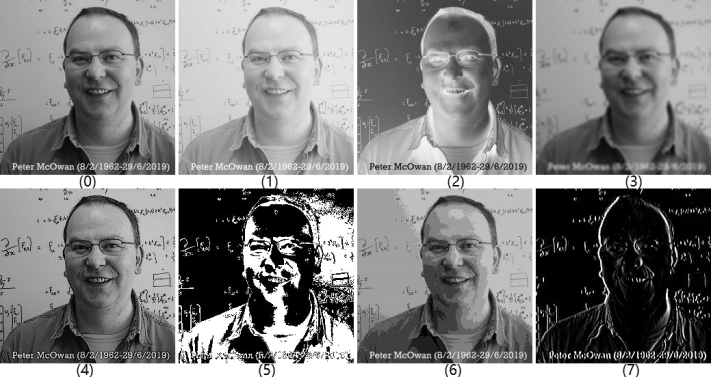关键词 > ECS776P
ECS776P Image Processing May Examination Period 2023
发布时间:2024-05-20
Hello, dear friend, you can consult us at any time if you have any questions, add WeChat: daixieit
May Examination Period 2023
ECS776P Image Processing
Consider the 4x5 image with a dynamic range of [0-9] as in Figure 1:
|
S1 |
S1 |
S9 |
S5 |
S5 |
|
S2 |
0 |
1 |
2 |
S6 |
|
S3 |
3 |
6 |
9 |
S7 |
|
S4 |
S4 |
S9 |
S8 |
S8 |
Figure 1 An image of size 4x5
where S1-S2-S3- …S8-S9 are the 9 digits of your student number, from left to right.
For example, if your student number is 123456789, the original image you use for this question is
|
1 |
1 |
9 |
5 |
5 |
|
2 |
0 |
1 |
2 |
6 |
|
3 |
3 |
6 |
9 |
7 |
|
4 |
4 |
9 |
8 |
8 |
Note that a few pixel values are independent of your student number.
Question 1 (Point Processing) [Total 25 marks]
a) Find the transformation for histogram equalisation of the original image in Figure 1 and give the resulting image after histogram equalisation has been applied. [10 marks]
b) By using the histogram of the image obtained in (a), describe a simple method to threshold the image and give the result. [5 marks]
c) Find the mean and the standard deviation of the image pixel values by using the histogram of the image obtained in (a). [5 marks]
d) Give the formulas for intensity transformation with Power Law while preserving the
dynamic range from 0 to 9, and show what the power should be if we wish to make the dark regions brighter. [5 marks]
Question 2 (Image Coding) [Total 25 marks]
a) What is the relations between the natural binary code and the Gary code? Give the bit- planes of the Gray code for the original image in Figure 1. [8 marks]
b) Calculate the entropy of the image in Figure 1. [5 marks]
c) Find the Huffman code for the image in Figure 1. [12 marks]
Question 3 (General image processing operations and image sampling) [Total 25 marks]
a) In Figure 2, the first image (0) is the original image and all the other images (1)-(7) are the results of the application of some image processing operations on (0). Identify what operation has been used to produce each of the images (1)-(7) from image (0), and justify your answers. [15 marks]

Figure 2 Original image (0) and the processed results (1-7)
b) After image enhancement, a student displayed the resulting images, but incorrectly, some very bright pixels were displayed as dark and some very dark pixels were displayed as bright. What could be the reason? How can we correct this error? [5 marks]
c) What does image resolution refer to in image processing? [5 marks]
Question 4 (image filtering) [Total 25 marks]
a) Show how a 1x3 mask and a 3x3 mask can be obtained to approximate the second-
order derivative of an image f(x,y),  [5 marks]
[5 marks]
b) Consider a piece of a line in an image with a dynamic range of [0-9] as [S1, S2, S3,
S4, S5, S6, S7, S8, S9],where S1-S2-S3- …S8-S9 are the 9 digits of your student
number, from left to right. For example, if your student number is 123456789, the
original image you use for this question is [1,2,3,4,5,6,7,8,9]. Show the result of the
convolution with the one-dimensional version of the mask obtained in (a). Indicate
where the edges would be detected and explain why. Use replicate border extension for the convolution. [8 marks]
c) Use your student number to fill in the following 3x3 image below:
|
S1 |
S2 |
S3 |
|
S8 |
S9 |
S4 |
|
S7 |
S6 |
S5 |
Figure 3 An image of size 3x3
where S1-S2-S3- …S8-S9 are the 9 digits of your student number, from left to right.
For example, if your student number is 123456789, the original image you use for this question is
|
1 |
2 |
3 |
|
8 |
9 |
4 |
|
7 |
6 |
5 |
For the 3x3 image in Figure 3, show the results at the centre of the image after applying i) the median filtering, ii) the mid-point filtering and iii) 4-neighbourhood Laplacian. [6 marks]
d) Give the sum of all the elements in an image filtering mask for i) Averaging, ii) Differentiation, iii) High-boosting, and explain why. [6 marks]

